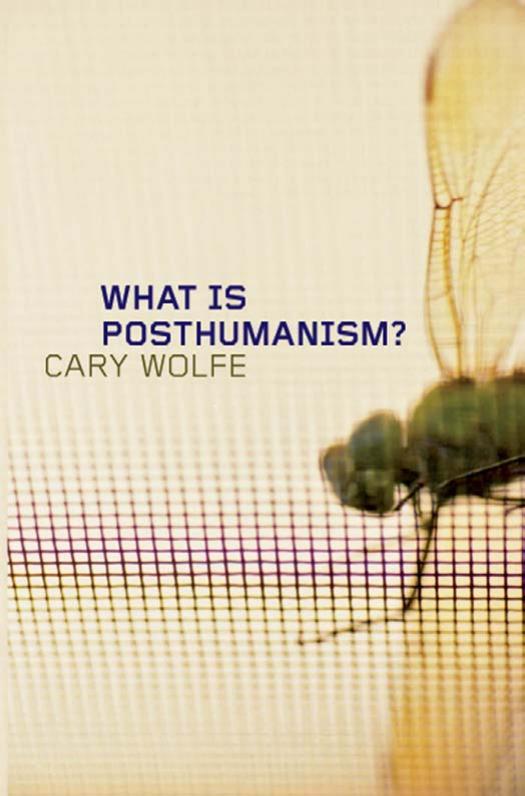What Is Posthumanism? by Cary Wolfe

Author:Cary Wolfe [Wolfe, Cary]
Language: eng
Format: epub, pdf
Tags: Humanism, History & Surveys, Movements, Univ Of Minnesota Press 2009, Philosophy, General
ISBN: 9780816666157
Google: TtxbuAAACAAJ
Amazon: 0816666156
Publisher: Univ Of Minnesota Press
Published: 2009-12-31T00:00:00+00:00
admitting that “the power of Dancer in the Dark is undeniable,” David
Ansen, in Newsweek, called it “a magnificent sham” riddled with “emo-
tional sadism. ”4
What is going here?
169
w h e n you c a n ’t b e l i e v e you r e y e s (or vo ic e )
To begin to answer that question, we need to get a fix on how
to approach this weird and iconoclastic film, what sorts of generic
expectations we may bring to it. That, however, is only the point of
entry into the much more complicated question I will take up later:
the question of what we might call the film’s ethical project and how
it might well be the source of its audience’s and reviewers’ hysterical
reactions (a term whose appropriateness will become clear, I hope, in
due course). To take up the question of genre first, we have to under-
stand that for Dancer in the Dark, any hint of “reality,” “character” in
the usual sense, verisimilitude, and the like are, for the purposes at
hand, the merest— and I do mean the merest— vehicles for the film’s
deeper concerns. Here it will suffice to simply register the shameless
melodrama of the plot: the incredibly innocent Selma (played by the
pop phenom Björk, in what nearly everyone agrees is a stunning per-
formance), who is slowly going blind, sacrifices her own life so that her
ten- year- old son Gene (Vladica Kostic) may receive an operation that
will save his sight from the ravages of the same congenital disease.
Dancer in the Dark, in other words, is no more satisfactory, fulfilling,
or compelling in terms of plausibility and Aristotelian necessity than,
say, The Marriage of Figaro— and that is precisely the point. In fact, the
film’s power is in a profound sense inseparable from what many view-
ers will see as its “absurdity” (if one wants to put it that way) precisely
in the way that the absurdity of opera (its melodrama, its hyperbole,
its staginess— all those qualities that make people either love or hate
opera too) is in fact absolutely central to opera’s philosophical and
ethical project. To put it as bluntly as possible, Dancer in the Dark, like
opera, isn’t about “reality”; it is about what “reality” turns away from,
and the “aversion” (to borrow an Emersonian term I will excavate later
on) of opera to that turning away. In that, it is (again like opera) more
real than reality— but more about that in a moment.
On the question of genre, it needs to be said that although
Dancer in the Dark invites us to make it legible within the genre of the
Hollywood musical, this is ultimately a blind alley. The film is not a
musical, at least not in that sense. While the musical insists on, as
a constitutive feature, the seamless continuity of the world inside and
outside the musical numbers themselves— characters engaged in “real-
istic” dialogue among passersby who (realistically) pay no attention to
170
w h e n you c a n ’t b e l i e v e you r e y e s (or vo ic e )
them suddenly break into song, and
Download
This site does not store any files on its server. We only index and link to content provided by other sites. Please contact the content providers to delete copyright contents if any and email us, we'll remove relevant links or contents immediately.
| Deconstruction | Existentialism |
| Humanism | Phenomenology |
| Pragmatism | Rationalism |
| Structuralism | Transcendentalism |
| Utilitarianism |
The remains of the day by Kazuo Ishiguro(8818)
Tools of Titans by Timothy Ferriss(8215)
Giovanni's Room by James Baldwin(7189)
The Black Swan by Nassim Nicholas Taleb(7010)
Inner Engineering: A Yogi's Guide to Joy by Sadhguru(6724)
The Way of Zen by Alan W. Watts(6504)
Asking the Right Questions: A Guide to Critical Thinking by M. Neil Browne & Stuart M. Keeley(5632)
The Power of Now: A Guide to Spiritual Enlightenment by Eckhart Tolle(5604)
The Six Wives Of Henry VIII (WOMEN IN HISTORY) by Fraser Antonia(5394)
Astrophysics for People in a Hurry by Neil DeGrasse Tyson(5130)
Housekeeping by Marilynne Robinson(4338)
12 Rules for Life by Jordan B. Peterson(4249)
Double Down (Diary of a Wimpy Kid Book 11) by Jeff Kinney(4206)
The Ethical Slut by Janet W. Hardy(4172)
Skin in the Game by Nassim Nicholas Taleb(4161)
Ikigai by Héctor García & Francesc Miralles(4124)
The Art of Happiness by The Dalai Lama(4063)
Skin in the Game: Hidden Asymmetries in Daily Life by Nassim Nicholas Taleb(3929)
Walking by Henry David Thoreau(3892)
